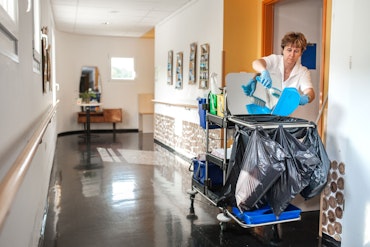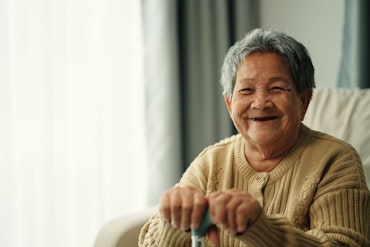How carers tackle a controversial decision and why they do it
Palliative care allows Australians at the end of their lives to be more comfortable, but some may chose another option
![<p>Palliative care is important to help Australians at the end of their lives as well as their families. [Source: Shutterstock]</p>](https://agedcareguide-assets.imgix.net/news/articles/wp/hugolderperson2810.jpg?fm=pjpg&format=auto&w=550&q=65)
Palliative care is important to help Australians at the end of their lives as well as their families. [Source: Shutterstock]
Key points:
- Health experts will gather with policymakers at this week’s Trans-Tasman Voluntary Assisted Dying Conference to share research about voluntary assisted dying and the impact on Australians
- The average age for palliative care-related hospitalisations is 75 years old, as per recent data from the Australian Institute of Health and Welfare
- Go Gentle Australia Chief Executive Officer Dr Linda Swan highlighted that ‘80 percent of people choosing voluntary assisted dying are also receiving palliative care’
Palliative Care Australia’s recent national survey highlighted a link between voluntary assisted dying and older Australians receiving palliative care, calling for more understanding regarding its use in healthcare settings.
The Trans-Tasman Voluntary Assisted Dying Conference, held in Brisbane from October 28 to 29, 2024 will host speakers including researchers from Edith Cowan University, the Australian Centre for Health Law Research and the University of Queensland to discuss the impact of voluntary assisted dying.
The average age for palliative care-related hospitalisations is 75 years old, as per recent data from the Australian Institute of Health and Welfare.
At any stage of a serious illness, the primary goal of palliative care is to provide supportive care and improve the patient’s quality of life by addressing painful or distressing symptoms.
It can be an important component of the treatment for long-term progressive conditions such as cancer, Parkinson’s disease, multiple sclerosis and heart disease.
Although palliative care is given to provide someone with a more comfortable end-of-life situation, some people may want to learn more about voluntary assisted dying.
Palliative Care Australia National Policy Director Josh Fear commented on the impact of increasing conversations about voluntary assisted dying for Australians seeking information.
“What we have heard from the sector is that the introduction of voluntary assisted dying in every state has led to an increase in conversations about end-of-life choices,” he said.
“That’s important because people choosing voluntary assisted dying should also have access to quality palliative care — it shouldn’t be one or the other.”
Although criteria vary slightly between states, people seeking voluntary assisted dying in Australia must be aged 18 years or over, be able to make their own decisions and have a disease that is likely to cause death within a certain timeframe.
Currently, voluntary assisted dying is illegal in the Northern Territory. The voluntary assisted dying bill was passed in the Australian Capital Territory on June 5, 2024, but will not commence until November 3, 2025, as per the Justice and Community Safety Directorate.
Eligible residents in Victoria, Western Australia, Tasmania, South Australia, Queensland and New South Wales can access voluntary assisted dying, dependent on specific eligibility criteria.
More information is available about voluntary assisted dying from the following organisations:
- the Victorian Department of Health;
- the Western Australia Department of Health;
- the Tasmanian Department of Health;
- SA Health;
- Queensland Health; and
- NSW Health.
The main types of voluntary assisted dying are either self-administration of voluntary assisted dying medication or administered by a healthcare practitioner.
Mr Fear highlighted that palliative care workers feeling confident when discussing voluntary assisted dying means that palliative care patients can learn more if they are interested.
“Encouragingly, the great majority of palliative care workers say they are comfortable providing information, support and care for someone accessing voluntary assisted dying,” he said.
“However, the findings I’ll share at [the] Trans-Tasman Voluntary Assisted Dying Conference also point to some challenges that warrant more attention, especially by providers who have a responsibility to facilitate patient choice.”
However, ‘at no time is a health practitioner allowed to initiate a conversation or discussion regarding voluntary assisted dying,’ according to information on the SA Health website. This is to ensure the patient has made the decision without coercion, direct or otherwise.
Go Gentle Australia Chief Executive Officer Dr Linda Swan highlighted the link between Australians in palliative care who chose the path of voluntary assisted dying.
“Our own State of VAD report shows that 80 percent of people choosing VAD are also receiving palliative care,” she said.
“We support the close collaboration of both services, with the aim of making the path from one to the other less disjointed and easier for terminally ill people.”
The Aged Care Guide contains information guides to explain palliative care in more detail, including: What is palliative care for? and The difference palliative care can make in the dying process.
Approximately 77 percent of palliative medicine attendance and case conference services were provided to Australians aged 65 years or older, according to recent data from the Australian Institute of Health and Welfare.
If this article has caused any concern or confusing feelings, help is available. Confidential and 24/7 support is available by calling Lifeline on 13 11 14 or visiting the Lifeline website.
What are your thoughts on voluntary assisted dying in Australia?
Let the team at Talking Aged Care know on social media.
For more information and news in the aged care industry, subscribe to our free newsletter.
Relevant content:
International Day of Older Persons to celebrate older Aussies and fight ageist stereotypes
Two-thirds of older Aussies are unprepared for bushfire season























